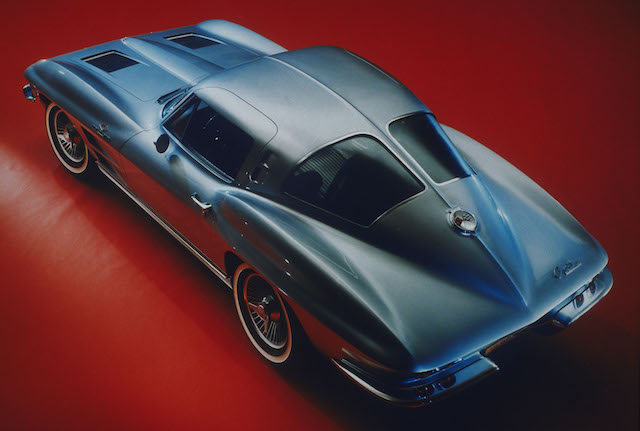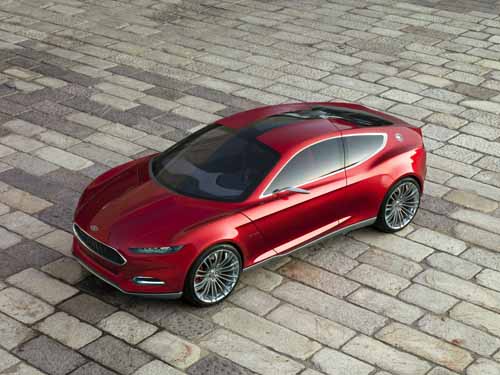THE AUTOEXTREMIST
 Tuesday, April 17, 2012 at 02:35PM
Tuesday, April 17, 2012 at 02:35PM April 18, 2012
The endless conundrum in the automotive design business: Design Predictability vs. Design Reach.
By Peter M. De Lorenzo
(Posted 4/17, 3:30 p.m.) Detroit. Continuing the discussion on the current state of automotive design from last week, as you read this the automotive enthusiast world is salivating at the thought that two reimagined American automotive icons are to be unveiled over the next eighteen months: the Chevrolet Corvette and the Ford Mustang.
Last August 31st, I wrote about the True Believers at GM and Ford who were feverishly working on the next-generation Corvette and Mustang:
As you read this, the True Believers at the Ford Motor Company and at General Motors are in the thick of reimagining two of America’s greatest automotive icons: the Ford Mustang and the Chevrolet Corvette.
For Ford, it’s a clear-cut case of coming up with an all-new Mustang to coincide with the legendary pony car’s 50th Anniversary in 2014. For GM the task is a bit more complex, as they’re working on two different cars at the same time: the upcoming seventh generation of the car, which is due in the spring of 2014 or thereabouts, and the “reach” car or the “clean sheet” eighth generation of America’s most enduring two-seat sports car, due approximately five years later.
The implications of the task at hand are crucial for both car companies, but let’s start with what Ford is dealing with first.
It could be argued that the Ford Mustang is much more clearly linked to the “face” of the Ford Motor Company than the Chevrolet Corvette will ever be linked to GM for the simple reason that Ford has always put the Mustang front and center, while GM, through its Chevrolet division, seemed to sporadically tout the Corvette over the years, but only when it was convenient or politically expedient within the company to do so.
In other words, the Mustang represents the very soul of the Ford Motor Company while the Corvette – though it could have and should have been the very essence of GM – has always been treated as an afterthought, except by the True Believers who worked on it, of course.
Last week I talked about the state of design and the sameness and expectedness that had crept into the art form, saying, Design reach and design risk have to make a comeback in this business and soon, because “me-too-ism” in automotive design doesn’t signal competitiveness; it just signals a level of blandtastic mediocrity, with everyone aiming for the middle.
I couldn’t imagine a more thrilling – and terrifying – assignment as a designer than to be saddled with coming up with the next generation of arguably the two most important icons of the American automobile business. But then again the Ford Mustang and the Chevrolet Corvette are much more than that when it comes right down to it, because they represent deep feelings and life memories for enthusiasts here and all over the world.
Yes, I know, for people who view automobiles as mere transportation devices, forgettable commodities or archenemies of The Green State, the pure unadulterated lust for these two machines is anathema and impossible to comprehend. But for automotive enthusiasts, the Corvette and the Mustang are not only lust-worthy, they’ve moved beyond iconic status to being full-blown national treasures.
And you just don’t mess with those feelings. Or do you?
In GM Design’s case, the Corvette is the Holy Grail. If you get to work on Corvette, there’s no doubt that you’ve reached the pinnacle within GM’s mythical design building. After seeing a young designer’s Corvette sketches hanging on a wall, Bill Mitchell once famously said, “Don’t kid yourself, kid. I do Corvette around here.”
That says it all, basically, because that’s how significant being entrusted to work on Corvette is. It was the highest honor, the peak of your profession. Yes, Mitchell did allow others to work on Corvette like the brilliant Larry Shinoda and the talented Peter Brock (who would go on to design the exquisite Shelby Daytona Cobra Coupe), but make no mistake, it was Mitchell’s call all the way.
Today, GM Design Chief Ed Welburn had to do it a little differently, because in today’s global GM he has design resources in centers all over the world. So he had a competitive bake-off just to see what he had out there. Given where the Corvette has been, and given the competitive nature of automobile design these days, Welburn understands perfectly that the Corvette is one car that can’t afford to be anything less than drop-dead spectacular. And he has told me that it was breathtaking and gratifying to see designers all over the world, with no direct experience with the Corvette, interpret the marque.
But then again, what is Corvette? From the very beginning the Corvette was bold, exuberant, “blue sky” and unapologetically American. It’s still America’s quintessential sports car. Even though the ’53 was iconic in its own right and the ’57 was equally so, it was the 1963 Corvette Stingray that remains the ultimate interpretation of what Corvette represents. The first Stingray was everything it could be, and more. And its impact on the streets and byways of America was shockingly memorable. Jaw dropping, even.
 (GM)
(GM)
The spectacular 1963 Corvette Stingray Coupe.
The ’63 Stingray resonates to this day and it remains one of America’s all-time great automobiles. But if you’re a designer, what does that mean, exactly? Do you go for nostalgia? In this day and age, no, it would be a death sentence for the car. Do you go for an evolving design that reassuringly looks like a Corvette, only reinterpreted for today? That would be the predictable, expected, inoffensive way to go. A fresh look at Corvette, and nothing more. The kind of car that in two years everyone will be looking at his or her watch, asking, “Uh, what’s next?”
Or do you go for it and push Corvette all the way beyond just a new interpretation, instead reaching for the next visual statement for the iconic nameplate? Ed Welburn showed the Corvette Vision concept (below) a couple of years ago and everyone oohed and aahed, especially over the clearly indicated “split-window” design element harkening back to the ’63.
 (GM)
(GM)
The Corvette Vision concept.
But is this the next-generation Corvette? No. The seventh-generation Corvette will be more evolutionary than revolutionary (the design was recently signed-off on by GM management, by the way). Will it be swoopy and dramatic? Yes. But will it reach far enough? I would say that the new car is cautiously exuberant, as if GM Design is holding back a little. It’s an update of the current vehicle package so there will be no surprises per se, as those will have to wait until the “clean sheet” eighth-generation Corvette around the 2018 time frame. So the new Corvette will be predictable with a dollop of reach.
Will that be enough? For a few years, certainly. But the moment the new Corvette is unveiled the clock will be ticking on the next one, that’s for sure.
And what about Ford and the next-generation Mustang? Everyone seemed to make a big deal about The Wall Street Journal story this week that the new Mustang coming in 2014 will not be a nostalgia rod but in effect an entirely new interpretation of what Mustang is, but that is no surprise if you know anything about the current design-think at Ford.
 (Ford)
(Ford)
An ad for the new Ford Mustang at the World’s Fair in New York, 1964.
Ironically enough, the Mustang made its debut at the World’s Fair in New York 48 years ago this week, going on sale April 17, 1964. The Mustang perfectly captured the burgeoning American sprit at the time. Edgy, irreverent, spirited, unexpectedly stylish and eminently affordable, the Mustang hit a broad spectrum of consumers right between the eyes to the point that the “gotta have” factor exploded right off the charts. The Mustang was the car of the moment, perfectly capturing America’s upward trajectory and giving everyone a piece of the action. It set sales records that will never be broken, recording 413,165 buyers in the first year. That’s a veritable frenzy, folks.
But that was then and this is next when it comes to the new Mustang at Ford. The Dearborn automaker has spent years and millions upon millions of dollars interpreting the Mustang aura, and they’ve done it extraordinarily well, especially over the last two iterations. But design predictability with the next-generation Mustang isn’t going to cut it this time, and everyone throughout the company understands that. They can’t go to the well one more time when it comes to the new Mustang, which is why the Evos concept that they recently unveiled speaks volumes about the new Mustang.
 (Ford)
(Ford)
The stunning Ford Evos concept.
Yes, they put the new corporate “face” on the concept to telegraph the front end of the new Fusion that makes its debut next September, but there’s no mistaking the proportions of the Evos, and it was clear that Ford Design was floating the overall package of the Mustang out there for all to see.
And the reactions were typical. The thoughts of the nostalgia/design predictability people could be summed up with the following obvious statement: “It’s nice but it’s no Mustang.” In other words the Evos just can’t be the new Mustang because it isn’t loaded up with enough design cues from the previous Mustangs to count as such.
If Ford pandered to these Mustang nostalgiaistas I can safely say that they would be in deep trouble. And instantly so too. If the next Mustang wallows in nostalgia the car will be sentenced to a very short shelf life, and in this climate Ford just can’t afford to do it that way.
No, it’s time for Ford to recreate and re-launch the Mustang aura to a new generation of buyers who don’t even know what the Mustang is, beyond its legendarily evocative name. Which is exactly why Ford designers will offer up a Mustang that will bristle with design reach, because to do it any other way would be a complete disservice to one of America’s iconic nameplates.
So in this era of design sameness and “expectedness” some of the most talented designers in the world have been working on reimagining America’s two greatest automotive icons, the Chevrolet Corvette and the Ford Mustang.
The task is invigorating, frightening and enormously crucial, and the impact of their final takes on what’s “next” for these cars will impact the futures of these two car companies for years to come.
It will be the ultimate test of design predictability vs. design reach.
And I can’t help but think that it’s the ultimate test of these two companies in other areas as well.
Their talent, their vision, their fundamental desire to succeed.
And their guts.
We shall see.
And that’s the High-Octane Truth for this week.
THE ALL-NEW AE STORE IS HERE!
CLICK ON THE PIC BELOW TO CHECK IT OUT!
See another live episode of "Autoline After Hours" with hosts John McElroy, from Autoline Detroit, and Peter De Lorenzo, The Autoextremist, and guests this Thursday evening, at 6:00PM EDT at www.autolinedetroit.tv.
By the way, if you'd like to subscribe to the Autoline After Hours podcasts, click on the following links:
Subscribe via iTunes:
http://itunes.apple.com/WebObjects/MZStore.woa/wa/viewPodcast?id=311421319
Subscribe via RSS:
http://www.autolinedetroit.tv/podcasts/feeds/afterhours-audio.xml
If you would like to read previous Autoextremist issues, click on "Next Entry" below.






